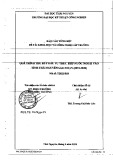
Hindawi Publishing Corporation
Journal of Inequalities and Applications
Volume 2011, Article ID 158219, 7pages
doi:10.1155/2011/158219
Research Article
LpApproximation by Multivariate
Baskakov-Durrmeyer Operator
Feilong Cao and Yongfeng An
Department of Mathematics, China Jiliang University, Hangzhou 310018, Zhejiang Province, China
Correspondence should be addressed to Feilong Cao, feilongcao@gmail.com
Received 14 November 2010; Accepted 17 January 2011
Academic Editor: Jewgeni Dshalalow
Copyright q2011 F. Cao and Y. An. This is an open access article distributed under the Creative
Commons Attribution License, which permits unrestricted use, distribution, and reproduction in
any medium, provided the original work is properly cited.
The main aim of this paper is to introduce and study multivariate Baskakov-Durrmeyer operator,
which is nontensor product generalization of the one variable. As a main result, the strong direct
inequality of Lpapproximation by the operator is established by using a decomposition technique.
1. Introduction
Let Pn,kxnk−1
kxk1x−n−k,x∈0,∞,n∈N. The Baskakov operator defined by
Bn,1f, x∞
k0
Pn,kxfk
n1.1
was introduced by Baskakov 1and can be used to approximate a function fdefined on
0,∞. It is the prototype of the Baskakov-Kantorovich operator see 2 and the Baskakov-
Durrmeyer operator defined by see 3,4
Mn,1f, x∞
k0
Pn,kxn−1∞
0
Pn,ktftdt, x ∈0,∞,1.2
where f∈Lp0,∞1≤p<∞.
By now, the approximation behavior of the Baskakov-Durrmeyer operator is well
understood. It is characterized by the second-order Ditzian-Totik modulus see 3
ω2
ϕf, tpsup
0<h≤t
f·2hϕ·−2f·hϕ·f·
p,ϕ
xx1x.1.3

2 Journal of Inequalities and Applications
More precisely, for any function defined on Lp0,∞1≤p<∞, there is a constant such that
Mn,1f−f
p≤const.ω2
ϕf, 1
√np
1
n
f
p,1.4
ω2
ϕf, tpOt2α⇐⇒
Mn,1f−f
pOn−α,1.5
where 0 <α<1.
Let T⊂Rdd∈N, which is defined by
T:Td:{x:x1,x
2,...,x
d:0≤xi<∞,1≤i≤d}.1.6
Here and in the following, we will use the standard notations
x:x1,x
2,...,x
d,k:k1,k
2,...,k
d∈Nd
0,
xk:xk1
1xk2
2···xkd
d,k!k1!k2!···kd!,|x|:
d
i1
xi,|k|:
d
i1
ki,
n
k:n!
k!n−|k|!,∞
k0
:∞
k10
∞
k20··· ∞
kd0
.
1.7
By means of the notations, for a function fdefined on Tthe multivariate Baskakov operator
is defined as see 5
Bn,df, x:∞
k0
fk
nPn,kx,1.8
where
Pn,kxn|k|−1
kxk1|x|−n−|k|.1.9
Naturally, we can modify the multivariate Baskakov operator as multivariate
Baskakov-Durrmeyer operator
Mn,df:Mn,df, x:∞
k0
Pn,kxφn,k,df,f∈LpT,1.10
where
φn,k,df:TPn,kufudu
TPn,kudu n−1n−2···n−dT
Pn,kufudu.1.11

Journal of Inequalities and Applications 3
It is a multivariate generalization of the univariate Baskakov-Durrmeyer operators given in
1.2and can be considered as a tool to approximate the function in LpT.
2. Main Result
We will show a direct inequality of Lpapproximation by the Baskakov-Durrmeyer operator
given in 1.10. By means of K-functional and modulus of smoothness defined in 5, we will
extend 1.4to the case of higher dimension by using a decomposition technique.
Fox x∈T, we define the weight functions
ϕixxi1|x|,1≤i≤d. 2.1
Let
Dr
i∂r
∂xr
i
,r∈N,D
kDk1
1Dk2
2···Dkd
d,k∈Nd
02.2
denote the differential operators. For 1 ≤p<∞, we define the weighted Sobolev space as
follows:
Wr,p
ϕTf∈LpT:Dkf∈Lloc˙
T,ϕ
r
iDr
if∈LpT,2.3
where |k|≤r,k∈Nd
0,and ˙
Tdenotes the interior of T. The Peetre K-functional on LpT
1≤p<∞, are defined by
Kr
ϕf, trpinf
f−g
ptrd
i1
ϕr
iDr
ig
p,t>0,2.4
where the infimum is taken over all g∈Wr,p
ϕT.
For any vector ein Rd, we write the rth forward difference of a function fin the
direction of eas
Δr
hefx⎧
⎪
⎪
⎨
⎪
⎪
⎩
r
i0⎛
⎝
r
i⎞
⎠−1ifxihe,x,xrhe∈T,
0,otherwise.
2.5
We then can define the modulus of smoothness of f∈LpT1≤p<∞,as
ωr
ϕf, tpsup
0<h≤t
d
i1
Δr
hϕieif
p,2.6
where eidenotes the unit vector in Rd,thatis,itsith component is 1 and the others are 0.
In 5, the following result has been proved.

4 Journal of Inequalities and Applications
Lemma 2.1. There exists a positive constant, dependent only on pand r, such that for any f∈LpT,
1≤p<∞
1
const.ωr
ϕf, tp≤Kr
ϕf, trp≤const.ω
r
ϕf, tp.2.7
Now we state the main result of this paper.
Theorem 2.2. If f∈LpT,1≤p<∞, then there is a positive constant independent of nand fsuch
that
Mn,df−f
p≤const.ω2
ϕf, 1
√np
1
n
f
p.2.8
Proof. Our proof is based on an induction argument for the dimension d. We will also use
a decomposition method of the operator Mn,df. We report the detailed proof only for two
dimensions. The higher dimensional cases are similar.
Our proof depends on Lemma 2.1 and the following estimates:
Mn,2f−f
p≤const.⎧
⎪
⎪
⎨
⎪
⎪
⎩
f
p,f∈LpT,
1
n2
i1
ϕ2
iD2
if
p
f
p,f∈W2,p
ϕT.
2.9
The first estimate is evident as the Mn,dfare positive and linear contractions on
LpT1≤p<∞. We can demonstrate the second estimate by reducing it to the one
dimensional inequality
Mn,1f−f
p≤const.
n
ϕ2f
p
f
p,2.10
which has been proved in 3
Now we give the following decomposition formula:
Mn,2f, x∞
k10
∞
k20
Pn,k1x1Pnk1,k2x2
1x1n−1n−2
×∞
0
Pn,k1u1Pnk1,k2u2
1u1fu1,u
2du1du2
∞
k10
Pn,k1x1n−2∞
0
Pn−1,k1u1∞
k20
Pnk1,k2x2
1x1
×nk1−1∞
0
Pnk1,k2tfu1,1u1tdt du1
∞
k10
Pn,k1x1n−2∞
0
Pn−1,k1u1Mnk1,1gu1,z
du1,
2.11

Journal of Inequalities and Applications 5
where
gu1tfu1,1u1t,0≤t<∞,zx2
1x1
,2.12
which can be checked directly and will play an important role in the following proof.
From the decomposition formula, it follows that
Mn,2f, x−fx∞
k10
Pn,k1x1n−2
×∞
0
Pn−1,k1u1Mnk1,1gu1,z
−gu1zdu1M∗
n,1h·,x
1−hx1
:JL,
2.13
where
hu1:hu1,x:fu1,1u1x2
1x1,0≤u1<∞,
M∗
n,1g,y∞
l0
Pn,lyn−2∞
0
Pn−1,ltgtdt.
2.14
Then by the Jensen’s inequality, we have
Jp
p≤T
∞
k10
Pn,k1x1
n−2∞
0
Pn−1,k1u1Mnk1,1gu1,z−gu1zdu1
p
dx
≤T
∞
k10
Pn,k1x1n−2∞
0
Pn−1,k1u1
Mnk1,1gu1,z
−gu1z
pdu1dx
∞
0
∞
k10
Pn,k1x11x1dx1n−2∞
0
Pn−1,k1u1
×
Mnk1,1gu1,z
−gu1z
pdzdu1
≤∞
k10
nk1−1
n−1∞
0
Pn−1,k1u1∞
0
Mnk1,1gu1,z
−gu1z
pdzdu1
≤const.∞
k10
nk1−1
n−1∞
0
Pn−1,k1u11
nk1p
ϕ2g
u1
p
p
gu1
p
pdu1.
2.15
However, by definition, one also has
ϕ2tg
u1tt1t1u12D2
2fu1,1u1tϕ2
2D2
2fu1,1u1t.2.16



![Báo cáo seminar chuyên ngành Công nghệ hóa học và thực phẩm [Mới nhất]](https://cdn.tailieu.vn/images/document/thumbnail/2025/20250711/hienkelvinzoi@gmail.com/135x160/47051752458701.jpg)






















